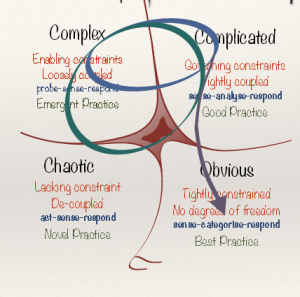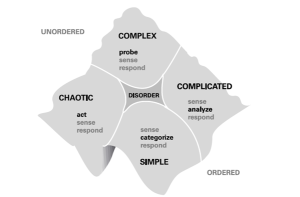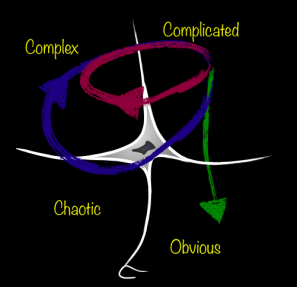
Firstly a very brief explanation of the Cynefin Model and why I find it highly valuable for innovation management.
Innovation has many characteristics of a complex adaptive system as I have crudely attempted to explain here.
The three primary states within the Cynefin framework are Ordered Systems (including Obvious and Complicated), Complexity and Chaos.
Order is split into two, as this handles a key difference in human knowledge between those states, where the cause and effect relationship is obvious and those where it requires greater analysis or expertise.
Exploring a process of emergent discovery for innovation
Most innovators are working in and certainly are far more familiar with the ordered domains, for ‘obvious’ innovations that extend, enhance or evolve their existing products and services.
Equally, they understand their more specialised place and contribution to be growing in their comfort, in the part they play in the more ‘complicated’ domain, where expertise, dedicated focus and specialization are often required or called upon.
The real challenges come from the really ‘new’ in innovation as it becomes greater in new designs, changing functionality, different technology or significant improvements on the existing that involved greater research and development the more you travel around the cynefin framework.
Here within this ‘ordered’ domain, the innovation activities are a lot more predictable, and more straightforward in their management. This is more about being trained, using expertise where needed, applying skills, making appropriate decisions, having established structures, processes and measurements and then systematically working towards clear objectives.
When you move across into the ‘complex’ or even ‘chaotic’ domains this takes on far more new learning, more situational assessments, looking and combining capabilities to manage emerging patterns and knowledge, applying experiences, looking for diversity of opinions and searching for new wisdom or insights.
Expertise and experience, collaboration and relationships need significantly leveraging. You often diverge/converge constantly as you work through the potential answers. The mindset here is different and it is more one that is based on the detection. Innovation is far more demanding, pushing frontiers, exploring discoveries, dealing in a series of exchanges and recognizing emerging patterns to piece together as real ‘new to the world’ innovation activities.
Let’s describe the domains within the framework
In the obvious domain of order, you assess the facts, categorize them, and then apply established practice. The system is well set up and you work through this in very controlled ways, you tend to adhere to the practices, always looking to improve and apply best practices. You sense- categorize- and respond as your work through the approach. Most of our incremental innovation ‘sits’ here as an extension to what we have established and where most systems, processes, technology understanding and controls are already established, all we are required to do is manage within a defined set of controls (constraints).
The complicated domain is where you tend to need greater expertise, initially, you might have multiple answers to your emerging concepts and you need to work through a better cause and effect so all involved can see the relationships. This is often termed the “known unknowns”. You sense- analyse- respond. This domain requires degrees of expertise and investigating various options and working eventually through the trade off’s. If a decision remains elusive then perhaps you have a more complex issue.
In the complex domain, you need to really work to extract the right answers. This is regarded as the realm of the “unknown, unknowns” and where much of our organizations have to work. Why simply because situations and decisions are far more complex as much is swirling around in unpredictability and flux. You are looking for more for the emerging patterns and you should avoid the attempt to impose a course of action or place ‘increased’ constraints here, you should allow the pathway to reveal itself.
For innovation here, you firstly probe- then sense- and then finally- respond. A solution or breakthrough will emerge and then you can begin to impose growing constraints, looking to move unordered thoughts or patterns into more orderly ones to evolve into final or potential solutions.
Avoid imposing order too early as this can preempt the opportunities for these ‘greater’ patterns to emerge. Leaders need to set the stage, step back, allow patterns to emerge and then determine which ones are more attractive or desirable.
Design thinking works well in this domain, where you visualize, synthesise, create narratives, build on learning stories, and explore multiple prototyping and safe-to-fail experiments.
When you are faced with a chaotic domain, this needs a rapid response. Searching for right answers can waste time, this is the realm of the “unknowables.” Cause and effect are impossible to determine as no manageable patterns seem to exist, only turbulence, challenge and threat.
The need is to quickly act, gain an early sense and respond. It tends to be the domain for top-down decisions, there is limited time for seeking input in ‘normal’ ways. This is the space where you ‘impel’ or ‘impose’ innovation.
Run a crisis team in parallel with an innovation solution solving team. Have one team managing the immediate to manage constantly changing issues incoming and another team working exclusively on exploring doing things differently to move from this chaos back into complexity.
Your innovation solutions have to counter the disruption or move beyond but the toughest part is ‘getting others to let go’. This requires clear leadership and direct communications to attempt to impose immediate actions and re-establish order.
There is a fifth domain, shown in the middle and that is disorder, not knowing which domain you are in and we often struggle to recognize which domain we want to be in for innovation and this disorder stays with us, until we impose order, structures or clarity to the thinking. The Cynefin model is highly contextual for innovation in my opinion.
Finally, to complete the understanding, the Obvious domain is next to Chaos because complacency (the extreme of Obvious) can all too easily produce catastrophic failure.
Thus that boundary is represented by a cliff, or more technically a catastrophic fold. You can find yourself moved from an orderly, steady-state, the business that is obvious to you and then thrown suddenly into chaos, by the sudden change. You fall off the cliff.
Recognizing and applying the different practices to each domain
Another important distinction within the model is around the type of practices each domain seeks out. In the obvious domain best practice rules, you are looking to constantly improve the innovation activity with repeatable, efficient structures and processes. Whereas in the complicated domain it is the search for good practices, the expertise deployed should bring this into the thinking.
On the other hand in the complex domain, you are searching for emergent practices, as you clarify, evaluate, probe and sense.
Finally, in the chaotic domain, this is more the application of novel practice, as you are ‘reacting’ to numerous situations where judgement and experience are applied to find original solutions to tackle mostly unique situations where you are learning as you go.
You achieve a greater depth in discussions and sense-making around different innovation needs using this framework
Cynefin thus contrasts how things are, with how we know them, with how we perceive them. The overall idea is that the more you allow these three to interact with each other the more likely it is that your actions with be authentic to the situation.
Cynefin goes well beyond a categorisation model that many try to use it for; it is about dynamic movements. So in the model shown above the prime dynamic is shown by the blue arrow.
Sometimes you can move between all four domains and this is shown as the green line (in the above depiction of the framework) and as innovation tends to be more in the complicated and complex space, you ‘operate’ more in these two modes.
So where does the model come from? Dave Snowden from Cognitive Edge. David is regarded as an authority on the application of complexity theory to organisations. David offers so much that is relevant to our work within or for organizations, to listen and learn from.
Innovation is complex and works well within the Cynefin model
 I like this as a discussional and resolution solving framework for innovation, as innovation can move across and between complex or complicated at different times, if it is more than ‘obvious’ incremental innovation. It attempts to place orders into the often unordered.
I like this as a discussional and resolution solving framework for innovation, as innovation can move across and between complex or complicated at different times, if it is more than ‘obvious’ incremental innovation. It attempts to place orders into the often unordered.
New ideas of innovation emerge in the complex domain and are often dependent on the constraints you impose to ‘extract’ and ‘yield’ choices.
You ‘toggle’ from exploration to exploitation across domains. The more you relax the more constraints can allow new possibilities to emerge. You want to eventually bring the unordered more in control and become more ordered.
From time to time the dynamic within an innovation concept may have ossified in which case a reset is needed; a shallow sudden dive into chaos. You are looking to bring the innovation out of this chaos domain as quickly as possible and impose some order (or constraints).
Only when change is no longer significant is it shifted to Obvious (formerly Simple) as the domain where incremental innovation resides as it relies more on repeatable structures and established practices.
We need to recognize different types of innovation need to be managed differently
I believe truly new (to the world) innovation is in mostly the complex domain and should be treated as such, often we don’t. We need to start with very open minds and then bring the thinking down.
We try to apply our existing practices and experiences best suited to regular or incremental innovation, found in the complicated and obvious domains, where practices constrain the idea more than we often want but sometimes need, as the ‘demands’ are imposed. We start to immediately probe and do not take the necessary time to analyse. We reduce the potential for greater innovation impact in applying constraints.
When you look at the four domains described here think of incremental innovation for working in the obvious, distinctive innovation for the complicated domain, radical or breakthrough for the complex domain and disruptive innovation when it comes to the chaotic domain. Think disorder when you have no established innovation system in place, just expecting innovation to happen!
Each of the above has significant innovation implications
The Cynefin model helps determine the ‘type’ of innovation and its complexity and the constraints you impose upon ‘it’. Recognizing the complexity that can hamper the effectiveness to innovation is very different from our usual management of effectiveness and efficiency.
Innovation requires boundaries but it needs the appropriate thinking, analysis and probing, this framework provides the ‘mechanism’ to promote this.
You need to build flexible systems that adapt, are dynamic and responsive and need that bandwidth for innovation exploration. It is a series of challenges evolving to be exploited, not reduced or eliminated.

Using the Cynefin model allows you to begin to think about the appropriate innovation and what is needed in practice and thinking approach.
It allows you to begin to be prompted in what the possible constraints might be, to allow you or not to explore innovation in these different domains.
To exploit innovation you need to manage it, manage it well, not as simple problems but within a better understanding of being a complex system, to extract the most from the investigation and discoveries.
It is deciding what complexity your innovation might have within the innovative design and then setting about building the right capabilities and framing these appropriately, where they matter.
My endnotes: I have drawn from different material associated with the work and explanations of David Snowden and Cognitive Edge extensively.
My innovation interpretations are built on this growing understanding and by using this model in my innovation discussions, by seeing its value and power for myself and through others. I just hope I have given justice to this fantastic model here.
BTW– The name Cynefin is a Welsh word whose literal translation into English, as explained by David is “as habitat or place fails to do it justice”. It is more properly understood as “the place of our multiple belongings” or “a sense of place” It is pronounced cunevin. The frame’s intent is to explore the relationship between man, experience, and context.
Reblogged this on Talent.
Hi, Paul. Good posting on explaining the Cynefin Framework. As one of many accredited Cognitive-Edge practitioners, I can certainly vouch for using the framework to explore possibilities in the Complex domain. The primary process is Probe, Sense, Respond which involves conducting safe-to-fail experiments in a disciplined manner. Besides adaptation, the ideas of exaptation, hunches, and serendipity can be included. I can also say as a past Lateral Thinking instructor I can very easily draw in Edward de Bono’s materials and Serious Creativity ideas – focus, challenge, concepts, provocations, information traps. Regarding “managing” innovation, I agree if managing is primarily about the process but not the content. In a complex adaptive system, we can influence people with probes, constraints, boundary changes but really want different ideas to naturally emerge from agent interactions. So, diversity (“more is more”) is really important as it allows tipping points (“more is different”) to emerge. We also search for new patterns (“more is interesting”) in the Complex domain that are the key to discovering the new attractor causing people to change their behaviours. This could be the fast Eureka! moment or, as Steven Johnson writes in his book “Where Do Good Ideas Come From”, the slow hunch that’s leads to a breakthrough.